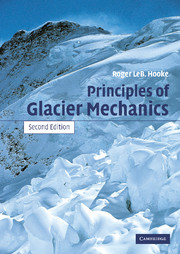Book contents
- Frontmatter
- Contents
- Preface to the first edition
- Preface to the second edition
- Physical constants relevant to ice
- Derived SI units and conversion factors
- 1 Why study glaciers?
- 2 Some basic concepts
- 3 Mass balance
- 4 Flow and fracture of a crystalline material
- 5 The velocity field in a glacier
- 6 Temperature distribution in polar ice sheets
- 7 The coupling between a glacier and its bed
- 8 Water flow in and under glaciers: geomorphic implications
- 9 Stress and deformation
- 10 Stress and velocity distribution in an idealized glacier
- 11 Numerical modeling
- 12 Applications of stress and deformation principles to classical problems
- 13 Finite strain and the origin of foliation
- 14 Response of glaciers to changes in mass balance
- Appendix: Problems
- References
- Index
5 - The velocity field in a glacier
Published online by Cambridge University Press: 24 November 2009
- Frontmatter
- Contents
- Preface to the first edition
- Preface to the second edition
- Physical constants relevant to ice
- Derived SI units and conversion factors
- 1 Why study glaciers?
- 2 Some basic concepts
- 3 Mass balance
- 4 Flow and fracture of a crystalline material
- 5 The velocity field in a glacier
- 6 Temperature distribution in polar ice sheets
- 7 The coupling between a glacier and its bed
- 8 Water flow in and under glaciers: geomorphic implications
- 9 Stress and deformation
- 10 Stress and velocity distribution in an idealized glacier
- 11 Numerical modeling
- 12 Applications of stress and deformation principles to classical problems
- 13 Finite strain and the origin of foliation
- 14 Response of glaciers to changes in mass balance
- Appendix: Problems
- References
- Index
Summary
Many problems in glaciology require an understanding of the flow field in a glacier. For example, the way in which flow redistributes mass determines the shape of a glacier, and also the rapidity with which glaciers respond to climatic change. Flow also redistributes energy and thus affects the temperature distribution. This, in turn, has important implications for the nature of the coupling with the glacier bed. Spatial variations in speed, or strain rates, are of concern to structural geologists using glaciers as analogs for deformation of rocks. From a geomorphic perspective, the entrainment of debris and the character of moraines constructed from this debris are dependent upon the flow field. In short, understanding the flow field is fundamental to the analysis of many problems in glacier mechanics.
For a full description of the flow field in a glacier, we need the horizontal and vertical components of the velocity at every point. By making several assumptions, we can obtain approximate solutions to this problem that will give insights into certain characteristics of glaciers and the landforms they produce. Initially, we will limit the analysis to two dimensions and also assume a steady state.
We will begin by studying the distribution of horizontal velocity. Given the pattern of accumulation and ablation over a glacier, we can use conservation of mass to determine the mean (depth-averaged) horizontal velocity.
- Type
- Chapter
- Information
- Principles of Glacier Mechanics , pp. 76 - 111Publisher: Cambridge University PressPrint publication year: 2005



